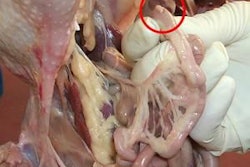
Jerry Weigel is the manager of nutrition, technical services and product application for BASF Plant Science LLC, located in Research Triangle Park in North Carolina. He is a nutritionist by training, having received a bachelor’s degree in agriculture from the University of Nebraska in 1971 and a master’s degree in nutrition from the University of Florida in 1973.
Since then, he has been involved in the plant genetics industry with positions at Savannah Foods, ADM, Exseed Genetics and since 1996, with BASF Plant Science. He is a proponent of special cultivars for the animal industry and has worked extensively with poultry, swine and cattle producers to commercialize BASF products including NutriDense™ corn with a higher energy value than conventional hybrids.
Feed Management : What is the current world situation with regard to GMO crops?
Jerry Weigel: The good news is there should be enough corn for everyone. In the U.S. 90% of plantings are with GMO cultivars. Brazil is now at 60%, Argentina, 50%. The situation in China is unknown, but we know that they are interested in optimizing production to feed their population which is demanding more animal protein from hogs and poultry. We believe that even the EU will adopt GMO seeds, but this will take some time. We have made inroads with potatoes and as ingredient prices rise and a greater proportion of imports are from countries which have adopted GMO the resistance of EU regulators will wane.
FM: What future trends do you envision in adoption of GMO?
JW: We believe that countries previously within the Soviet Block will adopt GMO including the Ukraine and the Russian Federation. Basically, we have maxed out improvements using conventional phenotypic breeding.
FM: How long does it take to develop a specialized strain?
JW: It takes approximately 15 years from obtaining germless to commercialization. It is also estimated that it costs over $20 million for the development of a genetically modified strain, again from gene discovery to marketing.
FM: Why have value-enhanced strains failed?
JW: Although plant breeders have overcome the agronomic hurdles such as yield and undesirable characteristics, most of the specialized products incorporate only a single trait such as high lysine, high energy or high oil content. These single traits do not offer sufficient return to either farmers or the intensive animal industry and hence consumers. Some strains selected for low phytic acid content in kernels, effectively have a higher energy content which may well be beneficial in the future. With genetic modification it is possible to stack genes and produce strains with multiple enhancements which are commercially more viable.
FM: How will diversion from corn to ethanol influence plant breeding?
JW: We do not believe that the current and future subsidized programs to produce ethanol will result in any change in the present direction of breeding. It will be possible by 2030 to harvest 300 bushels per acre. Admittedly this will involve additional costs in fertilizing and the product may have lower protein. We do not believe that there is any conflict between food and fuel in the U.S. To my knowledge there are no plant breeders currently developing hybrids for ethanol although there is some research and screening in this area.
FM: What are the prospects for cellulosic ethanol?
JW: The technical problems and the cost for production facilities suggest that predictions of commercialization by the current administration are far too optimistic. Financial institutions will be adverse to funding plants. Essentially the concept of cellulosic ethanol is on hold and may well die. By concentrating on yield improvements as we are doing, the starch content of kernels will be enhanced. From trials we know that strains yielding 200 bushels per acre will produce a kernel with 70% starch. With 300 bushels per acre, the starch content increases to 76%. Accordingly, breeding for yield will at the same time satisfy the needs of ethanol producers.
FM: What are the barriers to further adoption of enhanced value strains?
JW: Research and development is expensive, but our technology is continually improving. Currently, we are assigning resources to mapping metabolic pathways associated with the production of nutrients. A significant problem is obtaining germplasm. Patents and licensing are extremely complicated. Although there is a focus on opportunities with corn, it is well nigh impossible to obtain germplasm from competitors even if they are not pursing their own development programs. Dealing with the agencies representing national plant breeding centers is also difficult as they often have unrealistic expectations of financial return and impose onerous restrictions which impede access and progress.
The problems of identity preservation still persists but it may be possible to introduce value-enhanced strains to market if there is coordination within an integration or between feed producers and intensive animal enterprises and farmers or corporations operating large tracts of land.
FM: How do you view the activities of your competitors?
JW: There appears to be little activity in the development of enhanced value strains. At BASF, the program is unique being driven from the perspective of a nutritionist. We believe in “better corn for better feed”. It is possible to market a new strain with beneficial attributes only if it is yield-neutral and the nutritional benefits can offset at least a 25 to 50 cent/bushel premium for identity preservation. We believe that our Nutridense™ strain essentially primes the pump and will create demand for the product which will be driven by pork and poultry producers.
FM: Do you have any message for the feed industry?
JW: Our ability to produce new hybrids is limited only by our imagination. We need requests for products and we will consider both nutritional qualities in addition to other traits such as milling characteristics. We believe in ultimately satisfying the needs of the feed and animal industries by producing ingredients which can be incorporated in diets at a progressively lower cost to enhance productivity and profitability through the entire food chain.

















